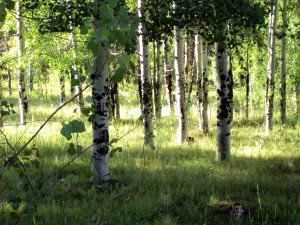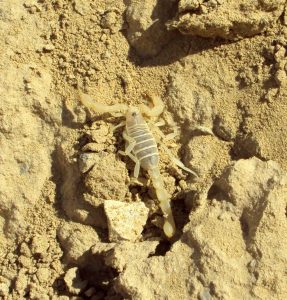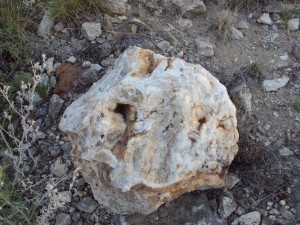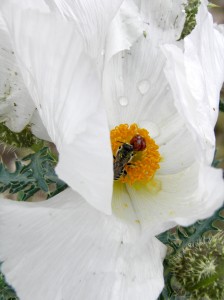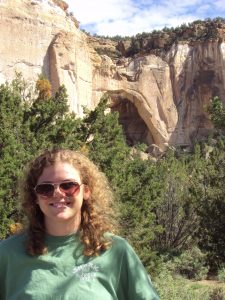My time here in WY is coming to a close, and it has been a busy season. From marking fences, to GIS work, to helping the Seeds of Success crew, I feel I have accomplished a great deal this season. My field partner and I spent the summer checking fences marked in a project started last season by another CBG Intern. 33,000 feet of fence was marked with vinyl J-channel markers, some with reflective tape, to increase visibility of the rangeland fences for wildlife to reduce mortalities because of fence collisions. (As you may not be a contractor and have no idea what vinyl J-channel even is, please see picture below. )

The primary species of concern in our project is the Greater sage-grouse (Centrocercus urophasianus), although it is our hope that big game species such as pronhorn antelope, mule deer, and elk will be positively affected as well. Interestingly enough, I have only seen living sage-grouse a number of times this season, only twice during work in the field. I have seen more than anyone’s fair share of bones. As unfortunate as it was to witness so many mortalities, especially with this species of great conservation concern, it was fascinating at the same time. Until now, I have not had the opportunity to learn so much about the bone structure and physiology of a specific species of bird. Did I think I would be a psuedo-archealogist and learning so much in-depth information about bones this season? Not really. But it has been a fun experience learning about a bird in a particular way I had not yet imagined.


My internship with CBG has been a great introduction to the BLM. I value the time spent here with this agency and the people in this district office. I have enjoyed learning so much about such a wonderful species as well as better understanding how much I already know. I never thought 4wd skills would be so helpful…
Monthly Archives: October 2010
Summer’s over — Time to Go Home
It’s amusing now to reflect on the day I crossed the Oregon border for the first time. Dougherty slide is one of the first landmarks one passes when driving into Oregon from Nevada. In addition to serving motorists as part of a highway, it serves hang-gliders as a drop point – steep is an understatement. Prior to reaching the slide, we spent hours on the straight, flat highways of Nevada’s desert. After this monotony, the signs warning travelers of the slide’s impending sharp downgrade seemed implausible. Suddenly, however, we drove out of a curve and Highway 140 appeared to drop away before us. From the summit the landscape plummets off the highway’s shoulder, impressively displaying the Lakeview Bureau of Land Management District. At the time, however, the land I surveyed through my windshield appeared anything but familiar. The high mountains, the lack of trees, and the expansive brownness of dry ground looked nothing like the mid-west and also nothing my preconceived notions of Oregon. On this day in June, I followed 140 in to Lakeview for the first of many times. In the following months, Molly (the other CBG intern) and I drove this road to and from our work sites almost every day. Over time its scenery, its sharps curves and its steepness over the two highest passes in Oregon became quite common place. Fittingly, in less than a week, I will drive this road one last time — back up Dougherty slide and home. As I reflect on my time in Oregon, I am most amazed at how quickly the alien ecosystems and experiences of my first few weeks here became familiar and comfortable – how I began to call this new place home.
In addition to the unfamiliarity of the landscape the people who I met on arrival in Lakeview seemed quite unfamiliar. During my first few days, I met character after character. Later in the summer Molly and I joked that the host of transient summer seasonals, quirky supervisors, eccentric town’s people and the “boys’-club” of post-adolescent fire fighters (stereotyped of course) we met here might make for entertaining reality television. Over the summer, my home, the government trailers at the Lakeview Interagency Fire Center, formed a center for a nebulous community of non-locals. In keeping with the reality TV metaphor, the trailers functioned as a “Real World-esque” pad where strangers arrived, lived, and worked before leaving again — forging relationships that produced both drama and merriment along the way. On the day I arrived, two Hawaiian fire-fighters greeted me to let me in. Prior to that day, I’d never actually met anyone from Hawaii and my two new roommates made quite the pair. One stood tall and skinny while the other cut a more compact figure –earning him the nickname “muscle hamster” later in the summer. The two maintained a constant, endearing banter and left our trailer noticeably quieter when they ultimately left. A few minutes later, a car pulled up and I met my roommate and crewmate, Molly. In some respects, Molly and I are opposites. She, for example, is quite quiet (especially with new people) and I, for example, am quite not. During the first few weeks, I mistook her silence for anger before learning otherwise. Building and maintaining a positive and effective working relationship with Molly may prove my most important personal growth experience of the internship. I have never spent so much continuous time with one person in my entire life and probably never will again.
For five months, Molly and I spent nearly twenty-four hours a day together – sharing a trailer camping, cooking, traveling and even grocery shopping together. This summer demonstrated that spending so much time with one person necessitates personal growth in order to remain friends at the end of the day. If communication felt strained to me at the beginning, over the course of the summer we tailored our phrasing to better understand each other. Furthermore, we learned to work through problems together – pitting ideas off each other and compromising to arrive at effective solutions. By the end, development of our non-verbal communication skills meant that we could even perform tasks without speaking at times. Our partnership forced both of us to evaluate the ways that we spoke or didn’t speak to each other so that we could work more efficiently and effectively as a team. While we learned to speak up to keep unhappiness from brewing and boiling, we also learned to let smaller grievances go – valuing the continuation of our positive working relationship over proving a point or “winning” an argument. We gained new respect for personal space – even when we had to find this space in silence at times. Over all, I feel lucky to have found a close friend in a person who I might not have befriended or ever chanced to meet otherwise. I feel a marked absence in our trailer and at work since Molly left Lakeview for home a week ago. After spending so much time working as a team it feels weird to work alone.

On Molly's last day we got to explore the Lost Forest in search of seeds. This amazing pine forest exists with very little water in the middle of the desert -- forty miles from the next forest.
In addition to solid communication skills, Molly and I made an effective team because that our skills complemented each other. While I have experience camping and hiking, Molly holds a wealth of knowledge about Botany. By contrast, despite taking a number of biology and ecology classes as an undergraduate, my transcript exposes the noticeable absence of a botany class. Before I started my internship, for example, buying a plant guide to the Pacific Northwest never even crossed my mind and this foresight betrayed my inexperience. More importantly, without taking botany, I lacked a taxonomic basis to help identify the plants that I saw or to mentally categorize these plants when I learned their names. On my first day of work I felt over-whelmed by the sheer number of plants I needed to learn and to learn quickly. Thanks to the patience of Molly and my mentor Brennan Hauk, however, I picked up this knowledge on the job and gained a whole new skill set to take home. After only a few weeks, I could identify most of the plants I passed as I collected seed. By the time my mom visited towards the end of the summer, I felt a great sense of accomplishment as I told her not only the common names but also the scientific names of nearly all of the plants we saw. Although a different flora covers Iowa’s prairies, I am excited to apply my new understanding of plant families to those plants communities. I also feel confident extending my botanical experience to future conservation jobs.
Over all, I feel really grateful for the opportunity presented by this internship. I learned a tremendous amount about plants and disturbance ecology – invaluable knowledge as I pursue a career in conservation and land management. Moreover, as our mentor gave us progressively more freedom to plan our own schedules over the course of the summer, he pushed us to act confidently and independently in the work place – to grow capable of navigating the adult world alone (with support) and to grow up. I improved my communication skills and made friendships as I dealt with not only Molly but everyone in the BLM office and in the greater Lakeview community. Finally, I had an awesome summer in a beautiful place that I probably never would have even visited if not for this internship. Thank you to the Lakeview BLM and CBG for everything.
Amy Hadow
BLM
Lakeview, OR
Good time in Pinedale
It is sad to think that my time in WY is coming to an end. I have had an amazing and memorable time here in Pinedale. When I first learn that I would be placed in Pinedale I was slightly concerned. All I was told was I would be living in an extremely small town in the middle of nowhere, but only after a short amount of time I fell in love with the place. In Pinedale I am surrounded by mountains, tons of outdoor activities, and some the nicest people I have ever been around.
I have enjoyed working with the BLM and getting to know the inner workings of a government agency. I have learned a fair amount during my 5 months here doing SOS and weed monitoring. I was very fortunate to work with fantastic people during my time here. The last few weeks I have been able to work with the wildlife crew doing pigmy rabbit surveys, giving me a chance to get new experiences. Here are a few pictures of what I have seen and done.
There and Back Again, Part Three
It was mid-September. Six weeks left of our internship. Deadlines were set, stress was high. Then our mentors walked into our cubicle, wondering if they could ask us some personal questions. Nervously, Brittany and I listened, preparing ourselves for trouble. Our worrying turned out to be unnecessary – we were getting an extension to our internship!
So here we are, extended until February. We now have time to do all that needs to be done, experience a Colorado winter, and afford to visit our respective family and friends over the holidays.
Backtracking…
The bridge from August to September turned out to be the highlight of my year thus far. Brittany and I were sent to the 17th International Conference on Aquatic Invasive Species in San Diego. As newcomers to the scientific conference circuit, we marveled in every detail, every speaker, every experience. We were housed in the posh downtown Westin San Diego, mere blocks from San Diego Harbor, Little Italy, and the Gaslamp District. Our poster presentation was the first night of the conference – and boy were we nervous. It was one of the most nerve racking experiences of my life to date; representing THE National Park Service in a room full of respected biologists and invasive species experts. We came through it alive, thanks to our month of preparation, our mentor Rita’s presence and confidence in us, and the laid-back atmosphere of the room.
Once our poster presentations were over, we were able to breathe a sigh of relief and enjoy our fellow presenters. We became versed in a whole slew of the latest and hottest invasive species topics, including Asian Carp, dreissenids, ballast water policies, molecular techniques, aquatic plants, and crustaceans. It was such a pleasure to be immersed in the world of biology once again, learning from the best in the business. Although the topic of invasive species is a depressing and sometimes a helpless one, the confluence of passionate people from across the globe to help in this problem was extremely hopeful, and personally inspiring.
By conference’s end, Brittany and I had formed friendships and made connections from San Francisco to Belgium, from Romania to Australia, and everywhere in between. One of the conference go-ers organized a pelagic whale watching trip, and we obviously jumped at the opportunity. Many a seabird was spotted, as well as sea lions and seals and even a few whale spouts! It was such a thrilling experience, and made me yearn for my future career in marine biology to begin ASAP.
The rest of our time in San Diego was spent with friends in La Jolla. We spent most afternoons playing at Scripps Beach, where I gazed longingly at the Scripps Institute of Oceanography campus. I went surfing for the first time, taken so kindly by Tom Rottler, former T.A. for my father in Minnesota and current Director of Outdoor Recreation for UC San Diego. We were shown the great, local eateries. I tried my first sushi. I saw a real life lionfish at the Birch Aquarium at Scripps, and we got to be tourists at the San Diego Zoo. Long story short, I fell in love with California (big surprise, right?)
But the time came to drag our spoiled behinds back to the mountains and back to work and the real world. It took a few days for me to stop moping around, longing for the sound of the ocean and the Southern California sun on my face. The minute I got back, I began researching graduate schools (Scripps included!), marine internship opportunities, and signed up to take the GRE (wish me luck!)
Once back in the office, it was time to get down to business. With the additional three months, we could all breathe a bit easier while still working hard. Our current progress finds us with a total of 583 marine invasive species (a plastic number), and beginning to collaborate with the webpage developers in the office. Our first goal is to have the internal website (available and tailored for Department of the Interior staff), then using our extension to create an external website for the public. It has been a lot of hard, not always exciting, but rewarding, work. Things are finally coming to fruition and we are this close to an actual final product.
Keep an eye out for that Marine Invasive Species website!
Chenie Prudhomme National Park Service Fort Collins, CO









Colorado
10/17/10
My CLM internship is coming to an end and I am very grateful for having had this opportunity. I have gained more field experience and have had a glimpse into the world of government work. I have a better understanding of GIS through ESRI’s online training. I have developed botany skills that I previously did not possess thanks to the mentorship of Carol Dawson and Peter Gordon and to our daily outdoor adventures. I now possess a knowledge of and an appreciation for Colorado’s native flora. I had an excellent summer hiking through the foothills, mountains, and valleys of Colorado with my fellow interns. I appreciated the interest in our work that recreational hikers expressed and it was always fun to hear peoples’ reactions when I told them that I basically go on hikes looking for wildflowers for work.
To those considering applying for the CLM internship I think it is a great way to spend a summer and to gain field experience in the natural sciences. For me, pictures can be more persuasive than words, so I made this collage to speak louder about this internship.

Lakeview, Oregon — a pleasant community nowhere near a Lake
This is my second to last blog post. At this point — close to the end of my time in Lakeview, OR — I have significant material to reflect on. I feel comfortable in Lakeview now even though, at two thousand people, it is the smallest town I that have ever lived in. To make it clear, Lakeview lacks a lake (some might argue that it also lacks a view). Drought and the human need for water have shrunk the shores of nearby Goose Lake far out of Lakeview’s view. Perched amid mountains in the high desert, Lakeview’s barren, sagebrush speckled landscape is also unlike any other place I’ve ever lived or even seen. I find it very beautiful and yet also a poignant reminder of the environmental expense we pay to satisfy our lustful reliance on water. After working here for almost five months, I now associate Lakeview with the expansive upside-down blue bowl of the sky. Without the natural and man-made structures that block it in other parts of the country, one can experience the sky here in a uniquely complete way. I find this view quite freeing and fulfilling for the soul.
After five months in Lakeview, I also feel as though I’m beginning to understand its culture — especially after attending the Lake County Fair. Lakeview hosts this event — possibly the seminal event of the town’s identity — annually. On Labor Day weekend, ranchers and revelers of all ages inundate Lakeview from the surrounding communities to show their animals, and enjoy the entertainment provided by the rodeo, fair rides, and the unusually vibrant nightlife that the fair creates. This event also serves as a family, and high school reunion, reuniting love ones from all over as well as fueling a drastic (if fleeting) upturn in the town’s economy. In September, I took full advantage of what might prove to be my singular opportunity to attend the Lake County Fair. I smelled burning rubber and heard squealing tires as I watched the local destruction derby – the fair’s most popular event. (On derby day fair-goers begin lining up more than two hours early to secure a good seat). I also went to my first rodeo – experiencing a truly western culture that is foreign to most Iowans. At the rodeo I learned to identify saddle bronc, team roping, and bull dogging amongst other events. I also learned some of the rules and traditions regulating rodeos. In one exciting moment, a cowboy competing in the roping competition knocked the open the gate constraining a bronco used in the saddle bronco riding competition. Freed of his stall, the aggravated stallion careened into the competition ring, charging everything in sight and sending anyone not on horseback fleeing from the arena. The situation took numerous mounted cowboys and about ten minutes to resolve – with the cowboys finally wrangling the wild horse and returning him to his stall.
While the last month has seen some unique cultural events, seed collection has slowed. The end of September through October falls at an awkward point in the seed ripening schedule – after most of the grasses and forbs have lost there seeds but before the sage seed has ripened. On a positive note, this gap period has given us an opportunity to explore new areas in search of different plants with ripe seeds. Lately, we have filled our days by collecting Mountain Mahogany. We stumbled upon this hidden population on one such exploration expedition. Trees present the challenge of height. Despite its somewhat shrubby form, Mountain Mahogany seeds often hang from branches way above our reach. Therefore, over the past few weeks, in addition to hiking we’ve begun climbing to reach seed populations. We often find ourselves perched atop a protruding rock or amongst sprawling Mountain Mahogany branches. I appreciate this more difficult means of reaching seeds though – it keeps things exciting.
Amy Hadow
Lakeview, OR
Bureau of Land Management
Collecting seeds in the forest..
During the last couple of weeks of my internship we have collected seeds in the forest. We have collected wax currant, sticky currant (that has a blue berry!), Potentilla glandulosa and curl-leaf mountain mahogany. I have enjoyed collecting seeds from these plants especially mountain mahogany. To the right is a picture of the area where we have been collecting seeds.
While we were collecting seed from Potentilla glandulosa plants we climbed a ridge and stumbled upon a population of mountain mahaoney trees. It just so happened that we had recently looked up pictures of this tree and its seed, so we were able to easily identify it. We scouted the area and determined that there were enough trees and seeds for us to collect from the population. Both the tree and the seed are very interesting to me..
We have enjoyed collecting seeds from these trees! As you can see Amy is happily sitting in one of the trees to collect more seed.. she is a very diligent seed collector! I love these mountain mahogany trees. I think they look like something out of the loin king, especially because they grow on ridges and rock outcrops so a view of them from a distance really looks like a picture out of the loin king!
Thanks all!
Molly Baughman
BLM, Lakeview, OR
Seeds of Success in Colorado
06/20/10
An encounter with a bull snake has left me thinking, “This job is awesome!” After jumping back and taking a few long, quick, nervous strides away from what first appeared to be a rattlesnake I found myself smiling widely and feeling very lucky to have the outdoors as my work environment. This CLM internship has afforded me the opportunity to start to get a feel for working for the government at the BLM state office in Colorado while at the same time getting me outside in the foothills almost every day. As an ARRA SOS intern my primary responsibility is seed collection. Little BLM land is located near the Denver area so we have been exploring the Open Space Parks of Jefferson County. Here along the trails in the foothills the wildflowers are blooming and the colors are beautiful. Few populations are ready for collection so we are mainly scouting the parks, taking notes, and making reports. Hiking and searching for wildflowers, what a way to spend the work day!
Leaving Big Sky
Over the past five months I’ve been with the BLM as a wildlife biologist in Glasgow, Montana. As a result of the skills I’ve gained through this internship, I will be leaving early to fill a wildlife biologist position out east. I am surely going to miss working in the prairies and especially the people I’ve had the opportunity to work with and meet since arriving here.
I didn’t know what to expect when I arrived here, but over the past months I’ve really gotten to know this ecosystem and further understand the perils many of the wildlife species here are facing in light of extensive energy development and exploration. The work that the BLM does here is invaluable and further gave me a new perspective in the field of land management.
While here I have worked with a broad array of taxa such as: greater sage-grouse; mountain plovers; black-tailed prairie dogs; burrowing owls; insects (horray) and black-footed ferrets. Aside from the animals I’ve worked directly with, I have had the opportunity to spot many rare and endangered birds here in the prairies.
Being here has allowed me to broaden my background and build upon my previous skills. This is a program that fits perfectly between academia and a full-time career. I have been integrated into Federal work and treated as a professional. Montana is a state I plan on returning to in the future, it has a bit of everything! I will surely miss it.
I cannot speak highly enough of the people I’ve been working with and the CLM internship program! As a direct result of this internship I have been given a position in my desired field.
Best of luck to everyone!
Last few weeks on the Colorado Plateau
I am nearing the end of the internship now and have to say that I am very impressed with all I have learned about botany and about my own skills. I am now capable of making collections by myself in the field and identifying the plants successfully. Considering that I was not a botanist upon graduation, this is great. Even driving around in my home city, I recognize many species that I can recall the genus and species of with no problem. In addition, as I look back, I realize that a large part of the internship has involved extensive coordination of efforts and administrative tasks, and a lot of field work planning, and I have proven very capable of doing these things on my own in such a way where objectives get met and even exceeded.
I am also very impressed with the CLM internship program, as it has afforded me a fantastic opportunity for memorable field experiences in addition to the opportunity to put my skills to use and see what I can do for restoration. My career goals have come out the other side more defined, as I now know that I enjoy being in the field most and I am aware that the most enjoyable aspect of environmental science, for me, is environmental stewardship and even research therein.
There were many interesting adventures in the field, and I’ve seen and collected on so many different landscapes, from canyons, to deserts, to Pinon-Juniper woodlands, and even Ponderosa Pine forests. One of the more interesting experiences involved collecting prickly pear fruit. I suggest thick gloves for that one.
I’ve seen tarantulas, scorpions, owls, a rattlesnake, bats, and a wide assortment of insects and spiders. There is an abundance of fascinating yellow and black garden spiders in the grasslands and shrublands. We’ve collected wild raspberries, native grasses, a variety of different purple and yellow composites, thistles, lemonaide bush, globemallow, Apache plume, red bearberries, etc.
One of the coolest things about the internship is the sights you see while driving. The geology here in New Mexico is incredibly thought-provoking. I’ve passed by (and worked around, in some cases) volcanic fields, badlands, eolian sculptures, and travertine deposits. Some examples include the Mogollon-Datil volcanic field, the Angel Peak badlands, and Soda Dam near Jemez Springs. While it’s hard to believe New Mexico was once underwater, the evidence is everywhere, including in fossilized shells in several of the rocks I’ve found.
Since my last post, we have managed to meet our collection quota and then some. Conditions were just right for seed production and yield was great during the months of August and September, and continues to be great in October. For the past two and a half weeks I have been on my own in the internship and have been spending some time working with the other teams to see what SOS collection is like in other parts of New Mexico. I’ve found that in northern New Mexico, assemblages are very similar in some areas and hugely different in others, and that these differences seem most correlated with elevation. In those two and a half weeks, I have also managed five collections for the Los Lunas team.
The rains have tapered off a bit here and so has the heat (although Walnut Canyon seems to always be boiling hot during the day). Tomorrow I will be returning to a patch of BLM land near the small but quaint Pie Town, New Mexico, to continue with some collections that I began the week before last. Maybe I will stop and get some pie during my lunch break.
Tessia Robbins
Los Lunas PMC, NM















